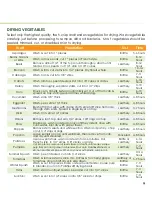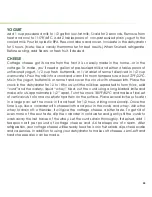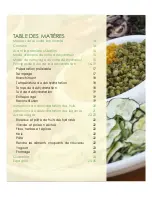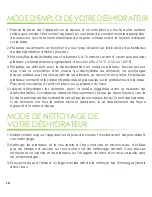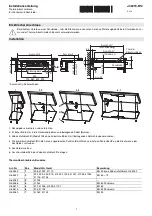
5
Wash produce before drying. Blot off excess water. Load trays with food that is sliced
evenly. As a tray is loaded, place it on the base platform to begin drying. During the
drying process, we suggest rotating the trays halfway thru the drying cycle.
pretreatiNg (optioNaL)
Pretreating food is not an essential procedure. However, pretreating will help maintain:
Color:
reduces oxidation of foods such as apples and potatoes keeping them from turning
brown.
Nutrients:
helps retain the minimal loss which tends to occur during the drying process.
texture:
lessens the chance for fiber deterioration in produce.
there are basically two types of pre-treatment, dipping and blanching.
DippiNg
Used primarily to prevent fruits or vegetables from oxidizing. the following are pre-treatment dips:
fruit Juice Dip:
Citrus juices, such as pineapple, lemon or lime, may be used as a natural
anti-oxidant. stir 1 cup of juice into 1 quart of lukewarm water and soak for 10 minutes.
sodium Bisulfate:
When mixed with water, sodium bisulfate is a liquid form of sulfur, only
use food-safe grade (UsP) sodium bisulfate. It is the most effective and least expensive
anti-oxidant. Use only a food-safe grade of sodium bisulfate that is made especially for
dehydration. If subject to sulfur allergic reactions, check with your physician before using
sodium Bisulfate as a dip. For Fruits, mix 1 1/2 tablespoons of sodium Bisulfate in one gallon
of water. soak fruit slices for 5-10 minutes. Rinse. For Vegetables, recommended for steam
blanching only. Add 1 teaspoon sodium Bisulfate to 1 cup of steaming water and blanch.
this is particularly recommended for vegetables to be stored in excess of three months.
ascorbic acid-Citric acid Dip
: is simply a form of vitamin C. Citric acid. soak the prepared
produce in a solution of 2 tablespoons of powder to 1 quart of water for 2 minutes.
DRYInG BAsICs









